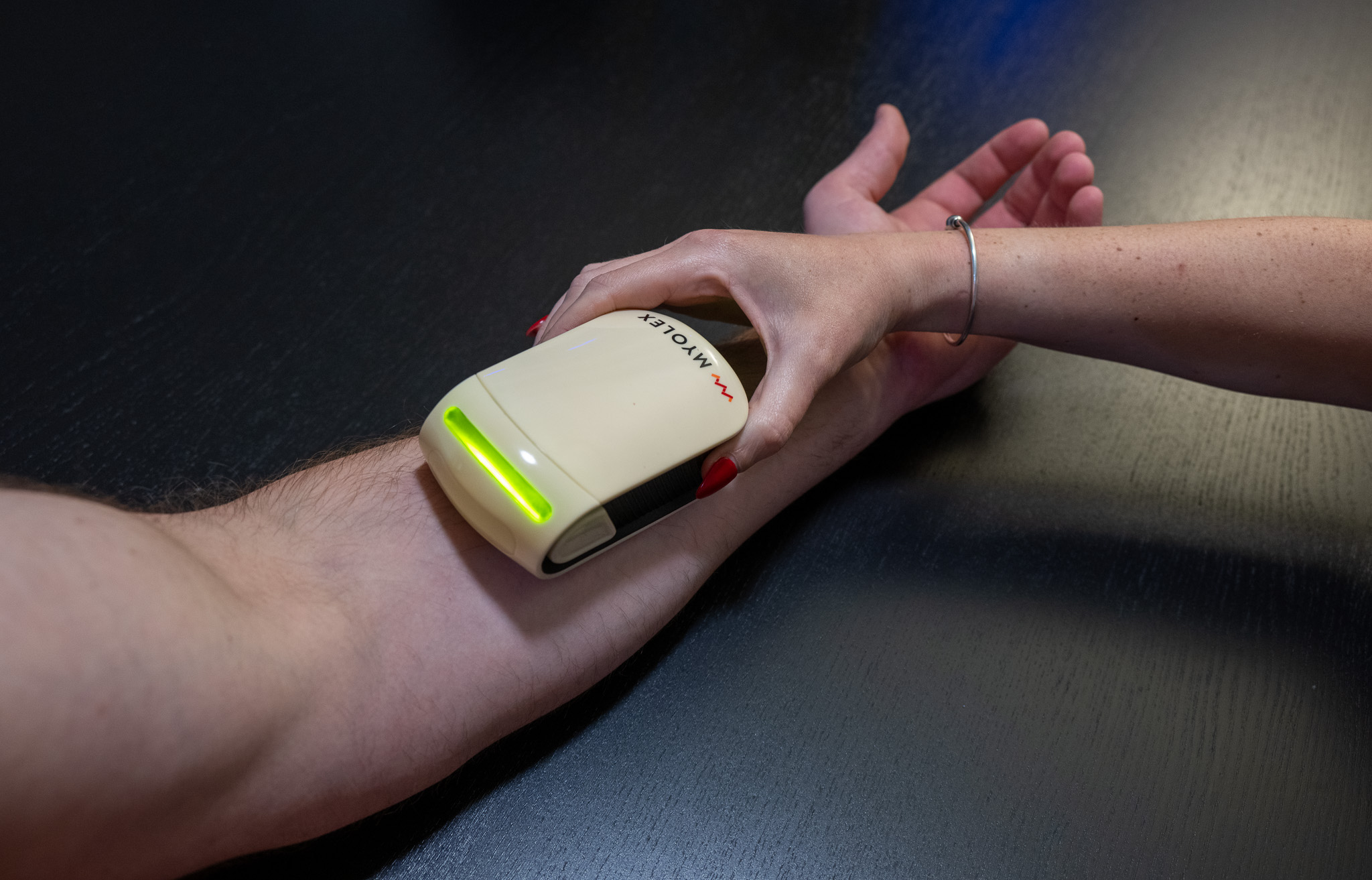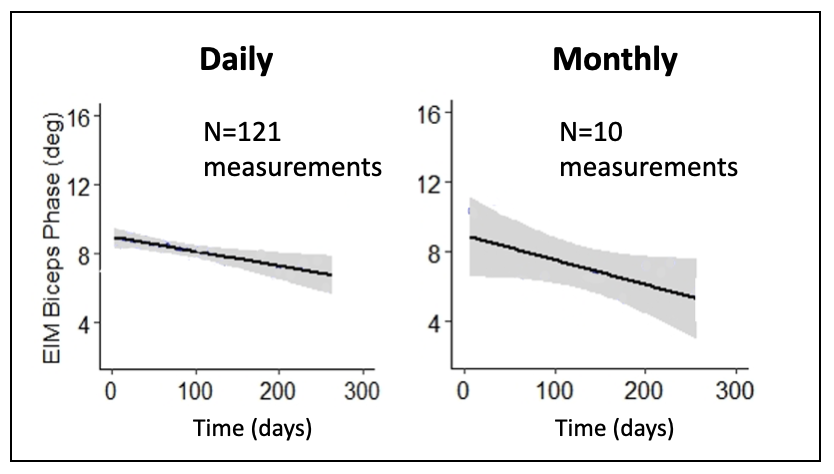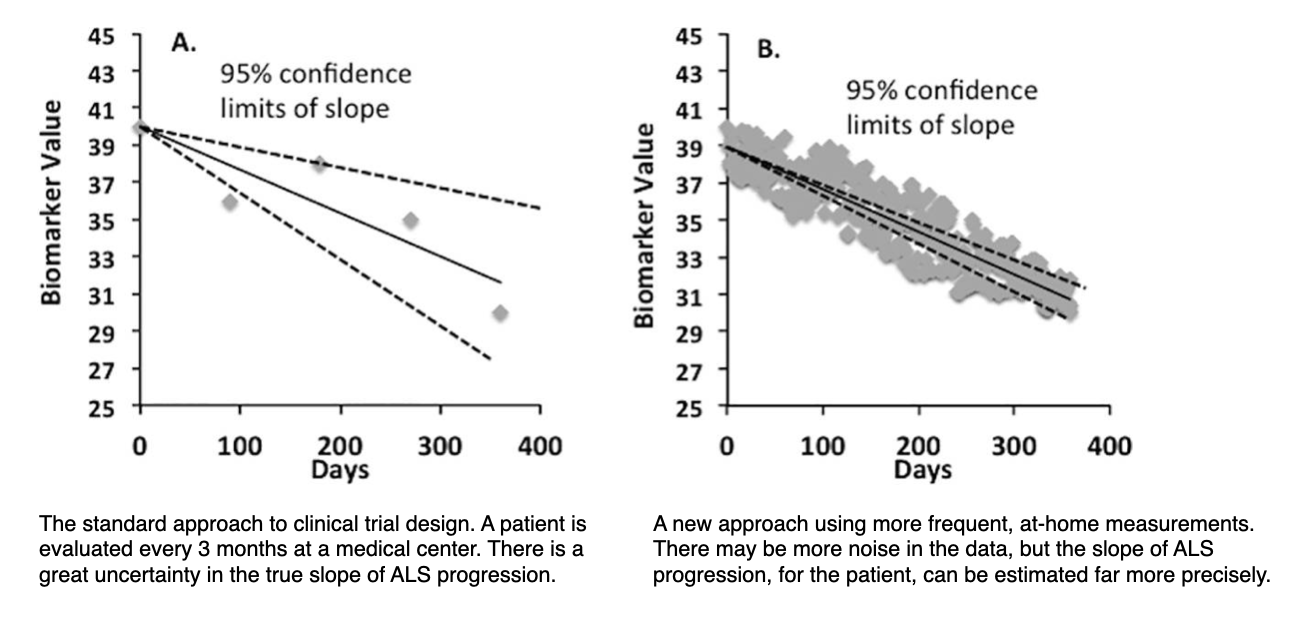Muscle wasting continues to grow due to aging and drug related side effects
“One of the biggest problems related to muscle evaluation in clinical practice is sarcopenia… there is no instrument that serves as a gold standard.”*
*Coronado-Zarco R, de León AO. Muscle quality an evolving concept. J Frailty Sarcopenia Falls. 2023 Dec 1;8(4):254-260.
Muscle wasting
Atrophy of muscles.
Muscle atrophy is the wasting (thinning) or loss of muscle tissue.
Muscle Wasting Causes
- Sarcopenia (age-related muscle wasting)
- Disuse (cachexia/cancer)
- Orthopedic and Sport Injury
- Drug Side Effects (e.g. Steroids, GLP-1 obesity drugs)
- Americans 65+ will reach 72M by 2030. Up to 30% over 60 will get sarcopenia.
- Muscle wasting increases fall risk. #1 cause of elderly injury death.
- 30M U.S. people projected to use GLP-1 obesity drugs by 2030 (JP Morgan). Millions could lose significant muscle mass.

Sarcopenia

Orthopedic & Sport Injury

Drug side effects

Disuse
Assessing Sarcopenia Accurately, Quickly, and Cost-Efficiently is Difficult
Sarcopenia, the pathological age-associated loss of skeletal muscle mass and function, is an important determinant of overall health in older adults.
- Muscle weakness may lead to falls, which can cause fractures and other serious injuries.
- Loss of muscle function is associated with slower walking speed. Decreased walking speed has been associated with a higher risk of mortality in population studies of older adults, especially those over age 75.
- Sarcopenia can also lead to disability and loss of patients’ ability to care for themselves.
The number of Americans 65 years and older is projected to roughly double to 95 million by 2060. Today, 42% percent of older adults have one or more physical limitations, in part, due to sarcopenia.

Wackerhage H. Sarcopenia: Causes and Treatments. Dtsch Z Sportmed. 2017; 68: 178-184.
Consensus is Growing for Muscle Quality Model
There was a way to assess morphological
muscle quality with one, comprehensive,
muscle scanning device that is easy
enough to use at home?
NEW MUSCLE QUALITY ASSESSMENT MODEL FOR SARCOPENIA*

*Charles Phillipe de Lucena Alves, et al. Muscle Quality in Older Adults: A Scoping Review, Journal of the American Medical Directors Association, Volume 24, Issue 4, 2023, Pages 462-467
MYOLEX EIM COMPREHENSIVELY ASSESSES THE CRITICAL ASPECTS OF MORPHOLOGICAL MUSCLE QUALITY

GLP-1 Muscle Wasting
Millions of people are now injecting weight loss drugs that are targeting Glucagon-like peptide-1 (GLP-1). Health benefits became apparent when obese people started rapidly losing weight, however, doctors also started noticing rapid losses in their patients’ muscle mass.
Clinical trials for semaglutide found 39–40% of weight lost on the GLP-1 drugs was lean mass. Often, twenty-five percent or more of the weight loss on these drugs is muscle. Loss of muscle mass is a major side effect of GLP-1 agonists.*
Importantly, the progressive loss of muscle can also make patients, especially elderly ones who already have less muscle to spare, even more frail and vulnerable to falls.**
*Alex Zhavoronkov, PhD. “Is There A Drug To Help You Lose Fat And Gain Muscle Without Exercise?” Forbes, 3 January 2024
**Sarah Zhang. “Ozempic Makes You Lose More Than Fat.” The Atlantic, 2 February 2024

Source: www.pharmaceutical-technology.com

New weight loss pharmaceuticals are now in all phases of clinical trials. They will all vary in the extent to which they affect muscle wasting. Measuring muscle wasting, in the clinic and at home, will become increasingly more important.
These clinical trials are also sure to increase the representation of older adults within those trials. The progressive loss of muscle can make patients, especially elderly ones who already have less muscle to spare, even more frail and vulnerable to falls.*
Fall risk is the #1 cause of elderly injury death.
*Sarah Zhang. “Ozempic Makes You Lose More Than Fat.” The Atlantic, 2 February 2024
Obesity Drugs: Why We Should Care About Specific Muscles
Not all muscles are created equally.

The predictive power of EIM to estimate myofiber cross-sectional area (CSA) histologically and approximate muscle triglyceride (TG) content biochemically.
Pandeya SR, Nagy JA, Riveros D, Semple C, Taylor RS, Mortreux M, Sanchez B, Kapur K, Rutkove SB. Predicting myofiber cross-sectional area and triglyceride content with electrical impedance myography: A study in db/db mice. Muscle Nerve. 2021 Jan;63(1):127-140.
What if…
There was a way to accurately, comprehensively, and cost-effectively measure changes in clinical subject’s muscle condition, once a week and/or before each GLP-1 dosage increase?


Source: The Care Pharmacy UK
There is a way. At home.
- In our ALS At Home Study, most clinical research participants completed the entire set of measurements within 20 minutes, over 92 days, and indicated that the study actually “made them feel more in control of their disease” (Ref. 13).
- By obtaining patient data far more frequently, clinicians were able to greatly increase their ability to accurately monitor muscle condition change over time (Ref. 13).
- In another study, daily, at-home measurements could be performed with a greater than 10X improvement over monthly measurements, in terms of reductions in sample size (Ref. 5).


Let’s Discover Together.

